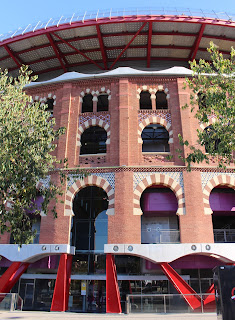We left the subway at Placa Espanya, and started up the hill toward the Palau Nacional. The fountains at the base of the hill are the famous "magic fountains" (the nighttime light & water show set to music).
The palace sits near the top of the 567-foot hill. There are steps, but escalators go up to all but the last level, so we didn't put Scott's ankle to the test.
The Palau was built for the 1929 International Exposition, but today houses the National Museum of Catalan Art.
Behind the Palau we found the Greek theater and the Olympic area, dominated by the 65,000-seat stadium. The stadium was originally built to host an anti-fascist alternative to the Berlin Olympics, but the event was canceled due to the outbreak of the Spanish civil war.
 |
| Olympic Statium |
 |
| Palau Sant Jordi &Torre Telefonica |
To the west of the stadium are some of the venues built for the Olympics, including the Palau Sant Jordi (gymnastics & handball) and the Piscines (swimming). Towering over the plaza is a striking tower. Initially, I thought this was the Olympic torch, but it turned out that it is a 446-foot telecommunications tower built to support the games. It represents an athlete carrying the torch.
As you look down the hill from the Palau Nacional, you can see the Placa Espanya and, beside it, the former bull ring. When we were here last, they were in the process of turning it into a shopping mall. We had to check out the finished product. About the only original thing left is the outside brick walls. Inside is four levels of shops, restaurants, a movie theater, and exhibition space. The rooftop deck provides panoramic views.
 |
| the original walls |
 |
| standing in the center of the ring, ground floor |
 |
| heading for the top |
 |
| Placa Espanya |




No comments:
Post a Comment